#Nilima Sheikh
Photo

Nilima Sheikh - Summer Tryst, 2004. Mixed tempera on vasli paper / 28.5 x 34 cm.
8 notes
·
View notes
Photo

Nilima Sheikh, We Must Bear, 2014
“We Must Bear, which Sheikh painted specifically for a solo exhibition at the Art Institute, comments not only on the troubles that have beset the Kashmir Valley since 1989, but also on the ongoing hardships its residents have borne over the centuries. The work is based on a quotation from a sixteenth-century verse by Nund Rishi (Sheikh Nuruddin Nurani), which can be seen at upper left. Kashmiris’ struggles are reflected by the weight of the body that the central figure is carrying across a field strewn with images of loss and war.” (from the Art Institute of Chicago)
6 notes
·
View notes
Text
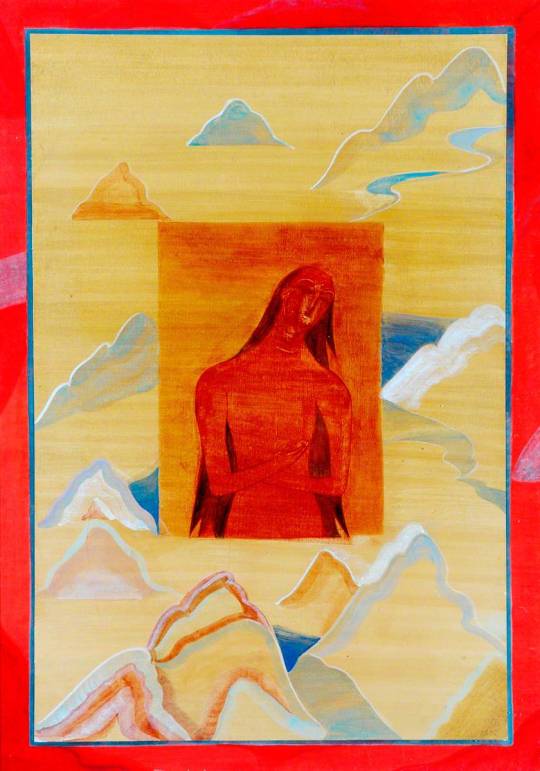
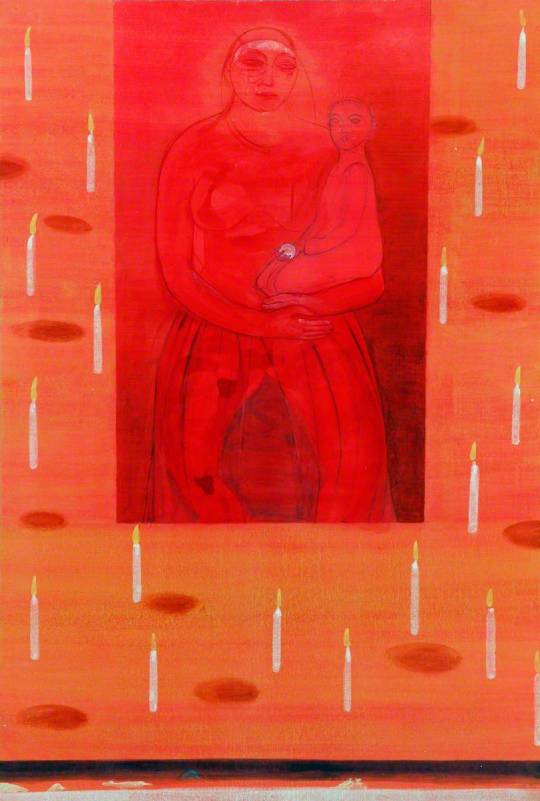

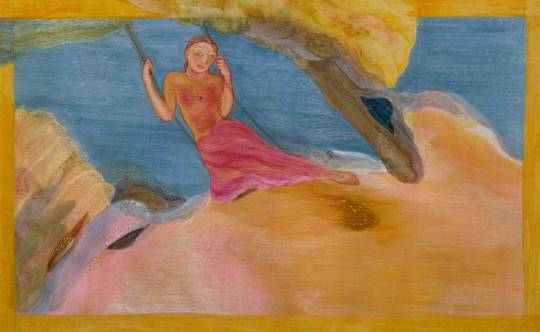
Nilima Sheikh
0 notes
Text
Terrain: Carrying Across, Leaving Behind
Terrain: Carrying Across, Leaving Behind
Artist: NILIMA SHEIKH
Nilima Sheikh, a Baroda-based painter, portrays the delicacy of the feminine in her faultless visual compositions by laying gold paint over washes of what many women’s past has been. Both men and women’s forsaken deeds reveal how vulnerability leaves wounds of various kinds for both sexes, portraying themselves as stories that come and go but never change. Her work…
View On WordPress
0 notes
Text
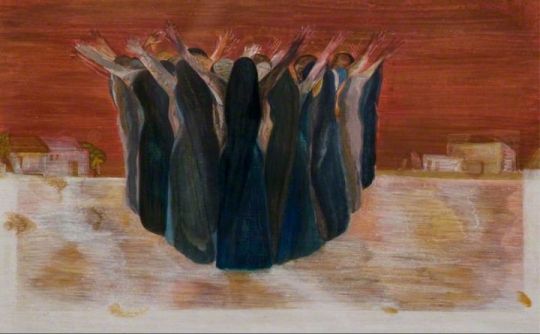
Nilima Sheikh (b.1945) - Ritualised Mourning, Marshia 1984–1985
36 notes
·
View notes
Photo

Nilima Sheikh. Ritualised Mourning, Marshia. 1984.
#Nilima Sheikh#lucas artists program#lucas artists fellows#Montalvo arts center#art#art residency#artist residency#painting#contemporary art#postmodern art#contemporary painting#Indian artist#female artist#feminist art#ritualised morrning#figurative#figure painting
143 notes
·
View notes
Photo

Nilima Sheikh (Indian, b. 1945) - Dream at Daybreak 3, Tempera on Sanganer vasli, 48.0 x 33.0 cm (2018)
223 notes
·
View notes
Text
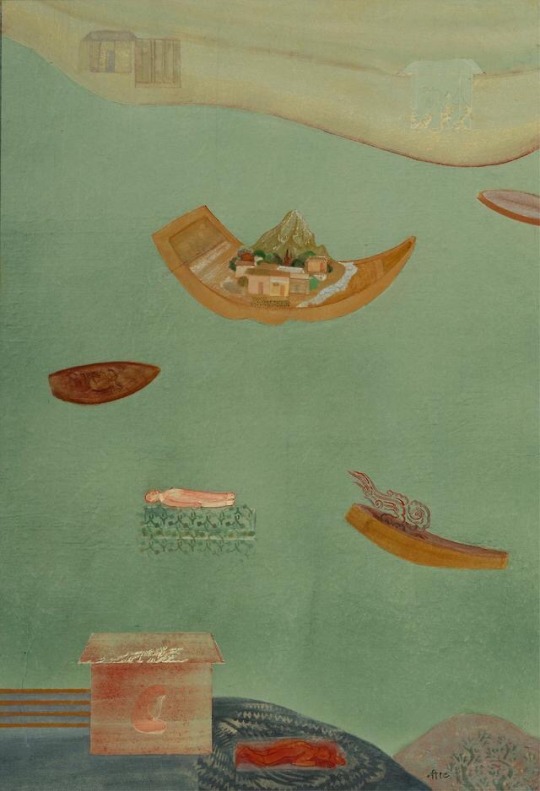
"Journeys 2", Nilima Sheikh, 2018. Tempera on Sanganer vaslil.
26 notes
·
View notes
Photo
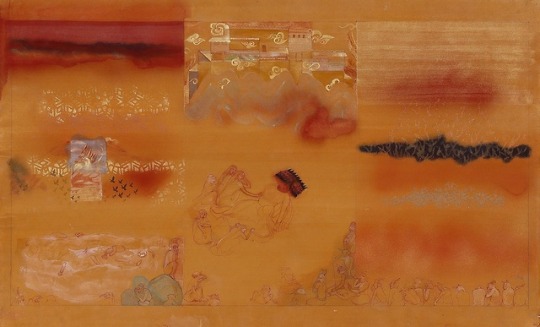
Nilima Sheikh - Dying Ravan (tempera on Sanganeri paper pasted on board, 2005)
40 notes
·
View notes
Photo

Artist of the Day
Nilima Sheikh
Mother Sequence
2016
Mixed tempera on sanganer paper
24.1 × 34.3 cm
Nilima Sheikh has inspired several generations over her 50 year career as a Baroda based painter. Sheikh has a solid position in the history of Indian Modernity, and was a student of KG Subramanian. Rooted in Eastern painting traditions such as miniature painting, oral tradition found in vernacular folk songs, as well as her own life experience, Sheikh continues to create bodies of work that evoke mystical imaginary landscapes that address feminine experiences. Sheikh has a gift for storytelling. Inspired by reading Rabindranath Tagore, the artist became interested at an early age in the connection between stories and images, an age-old connection from murals to ancient manuscripts. Beyond appropriating traditional techniques in her work, Sheikh works with figure and narration in her practice, which has also beautifully translated into theatre sets such as the 1993 Vivadi theatre production of Umrao, and also children’s books.
One series that earned Sheikh international acclaim and has exhibited extensively internationally was ‘When Champa Grew Up,’ a narrative and delicate 12 work series from 1984-1985 which revealed a tragic and too familiar story of a woman murdered for her dowry money by her husband’s family. Sheikh used traditional tempera painting techniques to question the darker sides of Indian traditions such as arranged marriages, which often subvert women. The artist used text from vernacular folk songs along with the paintings, a motif that has continued in her work decades later. Her painterly treatment of tempera also continues in her practice but in increasingly ambitious scales. In 1996, ‘Shamiana’ was unveiled at the Second Asia-Pacific Triennial, an installation with six hanging tempera on canvas scrolls, covered with a canopy made of synthetic polymer paint on canvas that referenced a marriage tent.
Beyond India, the artist turns to visual references from Kashmir, Turkey, Iran, and even pre-Renaissance Italian painting to create introspective works that question the meaning of the turbulent political landscape around her. Sheikh visited Kashmir often in her childhood, and was fascinated by it, but it was not until the 2002 Gujarat riots, which caused her immense internal turmoil, that she was able to directly address her connection with this state. Trained as a historian before she was trained as a painter, Sheikh delved into the history of Kashmir, and believes that Kashmir’s turmoil “is owing to our lack of understanding (of the place and people there) as Indians…The artist’s role is to bear witness - to both the past and present.” Two shows at Chemould, one in 2003 and one in 2010, address the artist’s deep concern with Kashmir. In the first exhibition, ‘The Country Without a Post Office: Reading Aga Shahid Ali,’ the artist connected with the Kashmiri poet’s words and illustrated the trauma found there and her thoughts with a vibrant and violent palette. In her 2010 show at Chemould Prescott Road, the artist exhibited a series of 9 painted scrolls reflecting her 8 years of arduous work called ‘Each Night Put Kashmir in Your Dreams.’ Her use of the motif of the scroll, a reference to Kashmir’s forgotten Buddhist past, allowed her to draw viewers into Kashmir outside of existing stereotypes which fuel the conflict that Sheikh hopes will diffuse with her lyrical works.
Anita Dube, the curator of the upcoming KMB that is hosted by the Kochi Biennale Foundation (KBF), announced Sheikh’s name as the First Artist for the fourth edition of Kochi-Muziris Biennale (KMB), which begins December 12, 2018
courtesy of artsy.net, gallerychemould.com
10 notes
·
View notes
Photo

Nilima Sheikh - Reading Agha Shahid Ali (Set of 38 Images), 2002-2003.
3 notes
·
View notes
Photo

Nilima Sheikh (L) and Geeta Kapur (R) standing before Hinnerk Scharder's site-specific artwork being installed at Kasauli Art Centre during the Indo-German Artists Workshop, September 1983. Image courtesy of Vivan Sundaram.
34 notes
·
View notes
Text
POPULATION
Abounaddara
Akinbode Akinbiyi
Nevin Aladağ
Danai Anesiadou
Andreas Angelidakis
Aristide Antonas
Rasheed Araeen
Ariuntugs Tserenpil
Michel Auder
Alexandra Bachzetsis
Nairy Baghramian
Sammy Baloji
Arben Basha
Rebecca Belmore
Sokol Beqiri
Roger Bernat
Bili Bidjocka
Ross Birrell
Llambi Blido
Nomin Bold
Pavel Brăila
Geta Brătescu
Miriam Cahn
María Magdalena Campos-Pons and Neil Leonard
Vija Celmins
Banu Cennetoğlu
Panos Charalambous
Nikhil Chopra
Ciudad Abierta
Marie Cool Fabio Balducci
Anna Daučíková
Moyra Davey
Yael Davids
Agnes Denes
Manthia Diawara
Beau Dick (1955–2017)
Maria Eichhorn
Hans Eijkelboom
Bonita Ely
Theo Eshetu
Aboubakar Fofana
Peter Friedl
Guillermo Galindo
Regina José Galindo
Israel Galván, Niño de Elche, and Pedro G. Romero
Daniel García Andújar
Pélagie Gbaguidi
Apostolos Georgiou
Yervant Gianikian and Angela Ricci Lucchi
Gauri Gill
Marina Gioti
Beatriz González
Douglas Gordon
Hans Haacke
Constantinos Hadzinikolaou
Irena Haiduk
Ganesh Haloi
Anna Halprin
Dale Harding
David Harding
Maria Hassabi
Edi Hila
Susan Hiller
Hiwa K
Olaf Holzapfel
Gordon Hookey
iQhiya
Sanja Iveković
Amar Kanwar
Romuald Karmakar
Andreas Ragnar Kassapis
Kettly Noël
Bouchra Khalili
Khvay Samnang
Daniel Knorr
Katalin Ladik
Lala Rukh (1948–2017)
David Lamelas
Rick Lowe
Alvin Lucier
Ibrahim Mahama
Narimane Mari
Mata Aho Collective
Mattin
Jonas Mekas
Angela Melitopoulos
Phia Ménard
Lala Meredith-Vula
Gernot Minke
Marta Minujín
Naeem Mohaiemen
Hasan Nallbani
Joar Nango
Rosalind Nashashibi and Nashashibi/Skaer
Negros Tou Moria
Otobong Nkanga
Emeka Ogboh
Olu Oguibe
Rainer Oldendorf
Pauline Oliveros (1932–2016)
Joaquín Orellana Mejía
Christos Papoulias
Véréna Paravel and Lucien Castaing-Taylor
Benjamin Patterson (1934–2016)
Dan Peterman
Angelo Plessas
Nathan Pohio
Pope.L
Postcommodity
Prinz Gholam
R. H. Quaytman
Gerhard Richter
Abel Rodríguez
Tracey Rose
Roee Rosen
Arin Rungjang
Ben Russell
Georgia Sagri
Máret Ánne Sara
Ashley Hans Scheirl
Marilou Schultz
David Schutter
Algirdas Šeškus
Nilima Sheikh
Ahlam Shibli
Zef Shoshi
Mounira Al Solh
Annie Sprinkle and Beth Stephens
Eva Stefani
K. G. Subramanyan (1924–2016)
Vivian Suter
El Hadji Sy
Sámi Artist Group (Keviselie/Hans Ragnar Mathisen, Britta Marakatt-Labba, Synnøve Persen)
Terre Thaemlitz
Piotr Uklański
Jakob Ullmann
Antonio Vega Macotela
Cecilia Vicuña
Annie Vigier & Franck Apertet (les gens d’Uterpan)
Wang Bing
Lois Weinberger
Stanley Whitney
Elisabeth Wild
Ruth Wolf-Rehfeldt
Ulrich Wüst
Zafos Xagoraris
Sergio Zevallos
Mary Zygouri
Artur Żmijewski
Zainul Abedin (1914–1976)
Stephen Antonakos (1926–2013)
Arseny Avraamov (1886–1944)
Ernst Barlach (1870–1938)
Étienne Baudet (ca. 1638–1711)
Samuel Beckett (1906–1989)
Franz Boas (1858–1942)
Arnold Bode (1900–1977)
Lorenza Böttner (1959–1994)
Marcel Broodthaers (1924–1976)
Lucius Burckhardt (1925–2003)
Abdurrahim Buza (1905–1986)
Vlassis Caniaris (1928–2011)
Sotir Capo (1934–2012)
Cornelius Cardew (1936–1981)
Ulises Carrión (1941–1989)
Agim Çavdarbasha (1944–1999)
Chittaprosad (1915–1978)
Jani Christou (1926–1970)
Chryssa (1933–2013)
André du Colombier (1952–2003)
Gustave Courbet (1819–1877)
Christopher D’Arcangelo (1955–1979)
Bia Davou (1932–1996)
Maya Deren (1917–1961)
Ioannis Despotopoulos (1903–1992)
Thomas Dick (1877–1927)
Carl Friedrich Echtermeier (1845–1910)
Maria Ender (1897–1942)
Forough Farrokhzad (1935–1967)
Conrad Felixmüller (1897–1977)
Pavel Filonov (1883–1941)
Niccolò di Pietro Gerini (1340–1414)
Tomislav Gotovac (1937–2010)
Jacob and Wilhelm Grimm (1785–1863, 1786–1859)
Ludwig Emil Grimm (1790–1863)
Giovanni di ser Giovanni Guidi (1406–1486)
Cornelia Gurlitt (1890–1919)
Louis Gurlitt (1812–1897)
Nikos Hadjikyriakos-Ghika (1906–1994)
Oskar Hansen (1922–2005)
Sedje Hémon (1923–2011)
Theodor Heuss (1884–1963)
Karl Hofer (1878–1955)
Ralph Hotere (1931–2013)
Albert Jaern (1893–1949)
Iver Jåks (1932–2007)
Sunil Janah (1918–2012)
Alexander Kalderach (1880–1965)
Tshibumba Kanda Matulu (1947–1981 disappeared)
Leo von Klenze (1784–1864)
Kel Kodheli (1918–2006)
Louis Kolitz (1845–1914)
Spiro Kristo (1936–2011)
KSYME-CMRC (founded 1979)
Anna “Asja” Lācis (1891–1979)
Maria Lai (1919–2013)
Yves Laloy (1920–1999)
Valery Pavlovich Lamakh (1925–1978)
George Lappas (1950–2016)
Karl Leyhausen (1899–1931)
Max Liebermann (1847–1935)
George Maciunas (1931–1978)
Ernest Mancoba (1904–2002)
Oscar Masotta (1930–1979)
Mikhail Matyushin (1861–1934)
Pandi Mele (1939–2015)
Tina Modotti (1896–1942)
Benode Behari Mukherjee (1904–1980)
Krzysztof Niemczyk (1938–1994)
Ivan Peries (1921–1988)
David Perlov (1930–2003)
André Pierre (1915–2005)
Dimitris Pikionis (1887–1968)
Dmitri Prigov (1940–2007)
Hasan Reçi (1914–1980)
W. Richter
Anne Charlotte Robertson (1949–2012)
Erna Rosenstein (1913–2004)
August Wilhelm and Friedrich Schlegel (1767–1845, 1772–1829)
Bruno Schulz (1892–1942)
Scratch Orchestra (1969–1974)
Tom Seidmann-Freud (1892–1930)
Allan Sekula (1951–2013)
Baldugiin Sharav (1869–1939)
Amrita Sher-Gil (1913–1941)
Vadim Sidur (1924–1986)
August Spies (1855–1887)
Foto Stamo (1916–1989)
Gani Strazimiri (1915–1993)
Władysław Strzemiński (1893–1952)
Alina Szapocznikow (1926–1973)
Yannis Tsarouchis (1910–1989)
Antonio Vidal (1928–2013)
Albert Weisgerber (1878–1915)
Lionel Wendt (1900–1944)
Johann Joachim Winckelmann (1717–1768)
Fritz Winter (1905–1976)
Basil Wright (1907–1987)
Andrzej Wróblewski (1927–1957)
Ivan Wyschnegradsky (1893–1979)
Iannis Xenakis (1922–2001)
Androniqi Zengo Antoniu (1913–2000)
Pierre Zucca (1943–1995)
Documenta14, 2017
9 notes
·
View notes
Text

Nilima Sheikh (B. 1945) - Akka Mahadevi, gum, casein and tempera on paper
14 notes
·
View notes
Photo

Manisha Gera Bawani, b. 1967
Self Portrait
India (c. 2010s)
[Source]
Artist, art collector and photographer Manisha Gera Baswani was often struck by the lack of candid portraits of contemporary Indian artists. “It all started with my artist friend Anjum Singh looking for a photograph of her mother Arpita Singh with fellow artist and friend Nilima Sheikh. The two had been friends for years and barely had photographs together,” she says.
Baswani, who describes herself as a happy trigger woman, also began revisiting the photographs she had taken over the years at different shows, and artist studios and homes around the same time. “I realised that there was a lot of history that was potentially getting lost.” It set her on a journey of photographing India’s exquisite art talent, one that led her to review her own art practice as well.
Over the last eight years, Baswani, who is based in Delhi, has been photographing other artists, many of whom are her peers. Some of the works from her portfolio were recently on exhibit at the India Art Summit in New Delhi.
The photographs aren’t those regular posed portraits you often seen in magazines. Much like a proverbial fly on the wall, she has hung around artists — in their studios, at galleries and at art exhibitions to capture candid portraits of the artists at work. Many look pensive; some seem lost in thought; others are caught talking to fellow artists. Her portrait of Mithu Sen has her reflected on a glass surface, appearing meditative. In another portrait, Neelima Sheikh walks across the venue of the India Art Summit, tenderly holding her grandchild.
5 notes
·
View notes
